Abstract
-
1.
Application of transepithelial square voltage pulses to the frog skin leads to responses in the transepithelial current and intracellular potential which include transient components. Determinations at 600 ms allow for meaningful estimates of basolateral membrane responses to transport modifiers.
-
2.
Oxytocin produced a large and sustained increase in the amiloride-inhibitable short circuit current (I m) which was accompanied by a large increase of both apical and basolateral membrane conductance (g a andg b, respectively). WhileI m andg a increased nearly simultaneously,g b started to increase several minutes after the increase in the two other parameters.
-
3.
Insulin also increasedI m,g a andg b. As with oxytocin, the increases inI m andg a often preceded the changes ing b.
-
4.
Ouabain reducedI m andg a. The effects ofg b were more complex, since sometimes the inhibition ofI m was first accompanied by an increase followed by a decrease while in other instances only minor changes in conductance could be observed.
-
5.
The currently available information regarding the control of cytoplasmic [Ca2+] and the effects of Ca2+ on cell membrane properties are used to construct a model in which changes in cytoplasmic [Ca2+] account for the observed behavior of the basolateral membrane.
Similar content being viewed by others
References
Bello-Reuss E, Grady TP, Reuss L (1981) Mechanism of the effect of cyanide on cell membrane potentials inNecturus gall-bladder epithelium. J Physiol (Lond) 314:343–357
Burch RM, Haluska PV (1984) ADH or theophylline-induced changes in intracellular free and membrane-bound calcium. Am J Physiol 247:F939-F945
Chase HS (1984) Does calcium couple the apical and basolateral membrane permeabilities in epithelia? Am J Physiol 247:-F869-F876
Chase HS, Al-Awqati Q (1981) Regulation of the sodium permeability of the luminal border of toad bladder by intracellular sodium and calcium. Role of sodium-calcium exchange in the basolateral membrane. J Gen Physiol 77:693–712
Chase HS, Al-Awqati Q (1983) Calcium reduces the sodium permeability of luminal membrane vesicles from toad bladder. Studies using a fast-reaction apparatus. J Gen Physiol 81:643–665
Els WJ, Helman SI (1981) Vasopressin, theophylline, PGE2, and indomethacin on active Na transport in frog skin: studies with microelectrodes. Am J Physiol 241:F279-F288
Erlij D, Schoen HF (1983) Barriers for Na and Cl movement across tight epithelia. Proc Int Union Physiol Sci 15:474
Erlij D, Smith MW (1973) Sodium uptake by frog skin and its modification by inhibitors of transepithelial sodium transport. J Physiol (Lond) 228:221–239
Erlij D, Ussing HH (1978) Transport across amphibian skin. In: Giebisch G, Tosteson DC, Ussing HH (eds) Membrane transport in biology, vol III. Springer. Berlin Heidelberg New York, pp 175–208
Frömter E, Gebler B (1977) Electrical properties of amphibian urinary bladder epithelia. III. The cell membrane resistances and the effect of amiloride. Pflügers Arch 371:99–108
Fuchs W, Larsen EH, Lindemann B (1977) Current-voltage curve of sodium channels and concentration dependence of sodium permeability in frog skin. J Physiol (Lond) 267:137–166
Grinstein S, Erlij D (1978) Intracellular calcium and the regulation of sodium transport in the frog skin. Proc R Soc London B 202:353–360
Gunther-Smith PJ, Grasset E, Schultz SJ (1982) Sodium-coupled amino acid and sugar transport byNecturus small intestine; an equivalent electrical circuit analysis of a rheogeic co-transport system. J Membr Biol 66:25–40
Latorre R, Miller C (1983) Conduction and selectivity in potassium channels. J Membr Biol 71:11–30
Lorenzen M, Lee CO, Windhager EE (1984) Cytosolic Ca2+ and Na+ activities in perfused proximal tubules ofNecturus kidney. Am J Physiol 247:F93-F102
Maetz J, Morel F, Race B (1959) Mise en evidence dans la neurohypophyse deRana esculenta L. d'un facteur hormonal nouveau stimulant le transport de sodium a travers la peau. Biochim Biophys Acta 36:317–326
Nagel W (1976) The intracellular electrical potential profile of the frog skin epithelium. Pflügers Arch 365:135–143
Nagel W (1978) Effects of antidiuretic hormone upon electrical potential and resistance of apical and basolateral membranes of frog skin. J Membr Biol 42:99–122
Rick R, Roloff C, Dörge A, Beck FX, Thurau K (1984) Intracellular electrolyte concentrations in the frog skin epithelium: effect of vasopressin and dependence on the Na concentration in the bathing media. J Membr Biol 78:129–145
Schoen HF, Erlij D (1981a) EMF across cell membranes of frog skin. International Biophysics Congress 7:349
Schoen HF, Erlij D (1981b) Sodium current across apical border of frog skin is described by the Goldman constant field equation. Physiologist 24:56
Schoen HF, Erlij D (1982) Transient responses and electrodiffusion across apical barrier of frog skin. Fed Prog 41:1263
Schoen HF, Erlij D (1983) Effects of ouabain on the apical and basolateral membranes of frog skin. Fed Proc 42:1101
Schoen HF, Erlij D (1985a) Current-voltage relations of the apical and basolateral membranes of the frog skin. J Gen Physiol 86: (in press)
Schoen HF, Erlij D (1985b) Neurohypophysial peptides influence both apical and basolateral membranes of frog skin Fed Proc 44:1567
Schultz SG (1981) Homocellular regulatory mechanisms in sodium-transporting epithelia: avoidance of extinction by “flush-through”. Am J Physiol 241:F579-F590
Schultz SG, Thompson SM, Hudson R, Thomas SR, Suzuki Y (1984) Electrophysiology ofNecturus urinary bladder. II. Time-dependent current-voltage relations of the basolateral membranes. J Membr Biol 79:257–269
Smith PG (1971) The low-frequency electrical impedance of the isolated frog skin. Acta Physiol Scand 81:355–361
Taylor A, Windhager EE (1979) Possible role of cytosolic calcium and Na−Ca exchange in regulation of transepithelial sodium transport. Am J Physiol 236:F505-F512
Van Driessche W, Erlij D (1983) Noise analysis of inward and outward Na+ currents across the apical border of ouabain-treated frog skin. Pflügers Arch 398:179–188
Vasalle M, Lee CO (1984) The relationship among intracellular sodium activity, calcium, and strophanthidin inotropy in canine cardiac Purkinje fibers. J Gen Physiol 83:287–307
Welsh MJ, Smith PL, Frizzel RA (1983) Chloride secretion by canine tracheal epithelium. III. Membrane resistances and electromotive forces. J Membr Biol 71:209–218
Author information
Authors and Affiliations
Rights and permissions
About this article
Cite this article
Schoen, H.F., Erlij, D. Basolateral membrane responses to transport modifiers in the frog skin epithelium. Pflugers Arch. 405 (Suppl 1), S33–S38 (1985). https://doi.org/10.1007/BF00581777
Issue Date:
DOI: https://doi.org/10.1007/BF00581777




